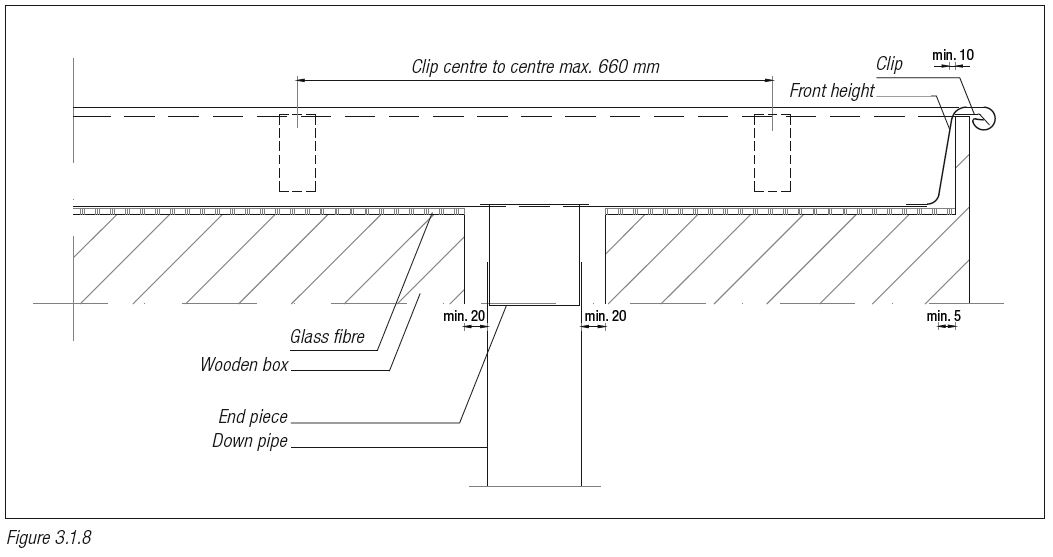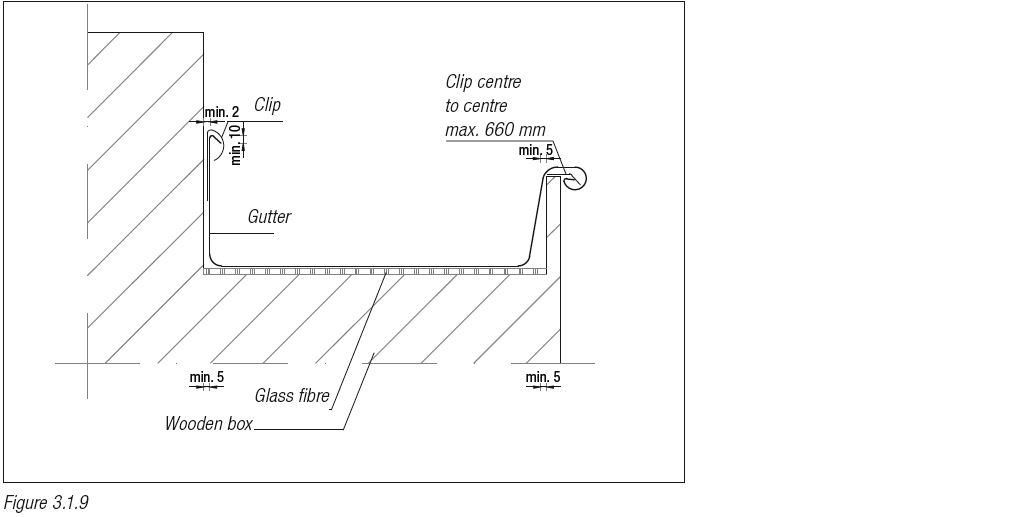Roof gutters in a wooden box
This type is fully supported by a structural construction. In most cases it consists of a wooden box structure.
Construction of the continuous support gutters
The support of zinc gutters with a continuous support is part of the architectural construction and is usually made of wood. Zinc gutters can be fitted perfectly to on unplaned timber. NedZink recommends that on new impregnated and glued wood a vapour permeable separation layer should be applied on the bottom of the gutter box to prevent damage from condensation on the backside of the zinc. The same advice also applies to supports made of concrete or other stony materials, where the dividing layer also prevents wear of the zinc. Before applying the zinc, check whether the supporting wooden box is clean and does not have any protruding nail heads or screws.
Are you interested in components that can be connected to zinc gutters with continuous support?
→ Click here for more information about roof gutters → Hide information about roof gutters
Measuring the box
The box is to be measured at various places and following measurements should be taken:
- Upper opening width;
- Bottom width;
- Height and slope of the front and back height;
- Thickness of the edge of the front height of the wooden box;
- Length of the different gutter surfaces.
Opening of the outlet piece
The outlet piece in the supporting box construction must be spacious enough to allow the gutter to contract and expand. This means the outlet piece, with the rain pipe slipped around it must have an oval cavity with at least 20 mm space to the left and to the right and in the other two directions, at least 5 mm.
Design of gutter
See figures 3.1.20 and 3.1.21. The following basic rules must be observed:
- The upper opening width of the gutter must be at least 4 mm smaller than that of the box.
- The bottom width of the gutter must be at least 10 mm smaller than that of the box.
- The height of the gutter must be 1 to 2 mm larger than that of the box.
- The bead protrudes over the edge of the box and does not rest on it.
- The back height must be at least 10 mm higher than the front height.
- The slope of the gutter is equal to that of the box including any bent forms.
- The further dimensional proportions have to be in accordance with NEN-EN 612.
- The ends of the gutter must have at least 10 mm space in relation to the ends of the supporting box.
Pre-processing of gutters
The zinc gutters are preferably prepared in the workplace as far as possible before installation, i.e:
- Gutter parts are cut to length.
- Corners mitres; if possible soldered.
- Soldering end pieces, expansion devices and outlet pieces.


Installation
- The bottom width of the gutter must be at least 10 mm smaller than that of the box. The back height min. 10 mm higher than the front height.
- The gutter parts must be preferably installed from left to right and against the slope (from low to high). The construction conditions may not always allow for this. When choosing another installation direction the installation from low to high is more important than from left to right (drainage overlap!).
- Clips are attached at the edge of the front height of the box with a minimum width of 70 mm and a thickness of 0.80 mm. Attach the clips with 3 galvanised or stainless-steel flat-headed nails. A clip must pierce approximately ¾ into the bead. Secure the gutter with clips of 30 mm wide at the rear upright. The maximum clearing distance is 660 mm.
- If the bottom width of the gutter is greater than 300 mm, a clip must be applied under the seam on the bottom of the gutter. The overlap of the clip must then be 25 mm and the clip may not be soldered.
- The distance between the clips is max. 660 mm centre-to-centre. Clips of min. 30 mm width are further attached to the wooden back height at the same distances and are bent over the water check of the gutter.
- The outlet piece in the supporting box construction must be spacious enough to allow the gutter to contract and expand. This means that the outlet piece, with the rain pipe slipped around it must have an oval cavity with at least 20 mm of space.
Support
The support is part of the building construction and is usually made of wood. Gutters of NedZink material can be applied directly to unplaned wood. NedZink recommends installing a vapour-permeable layer on newly-impregnated and bonded wood at the bottom of the gutter box in order to prevent attack by condensation on the backside of the zinc. The same advice also applies to supports of concrete or other stony materials, where the separating layer also prevents wear on the zinc. Before applying the zinc, check that the supporting wooden container is clean and does not contain protruding nail heads or screws.